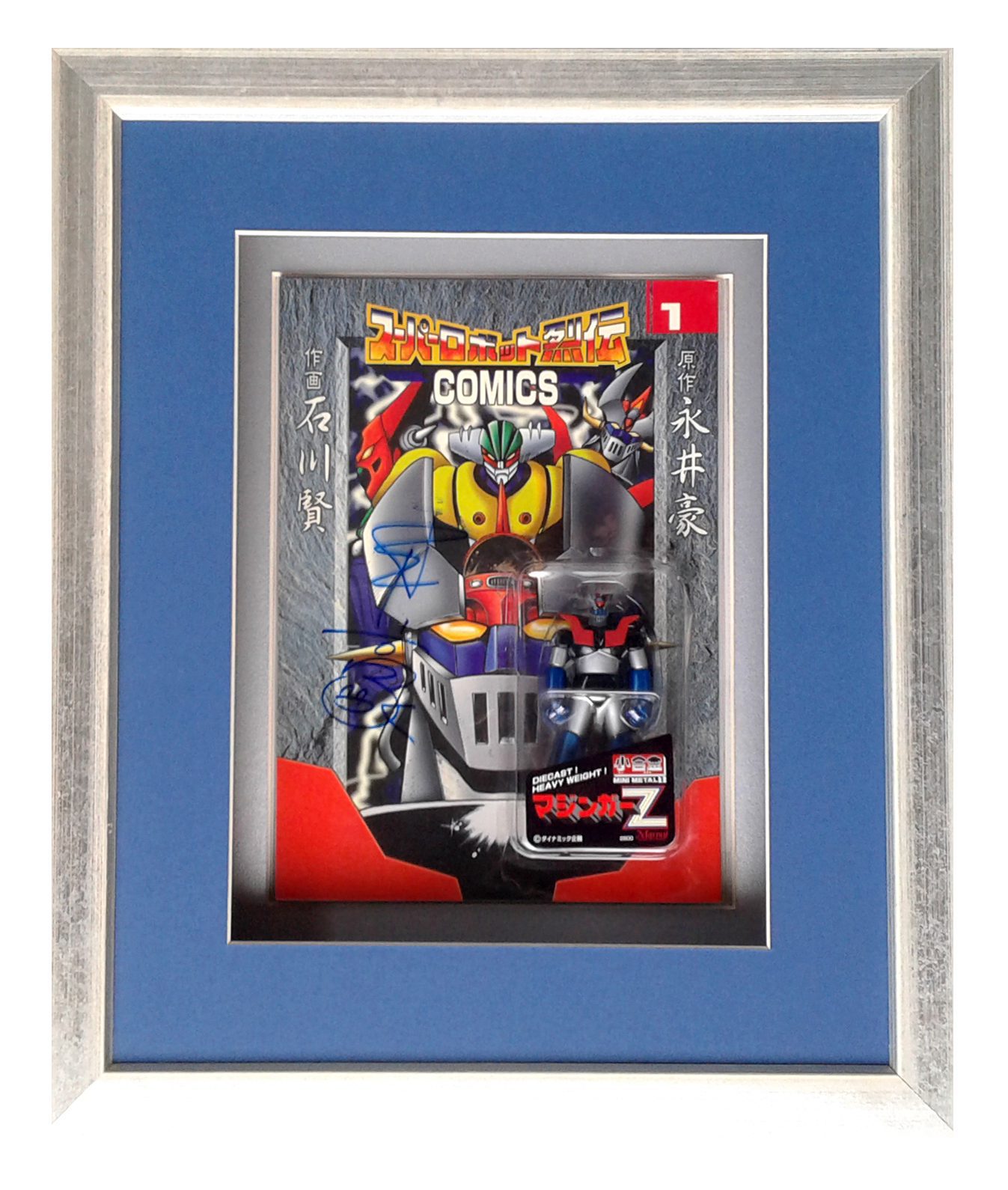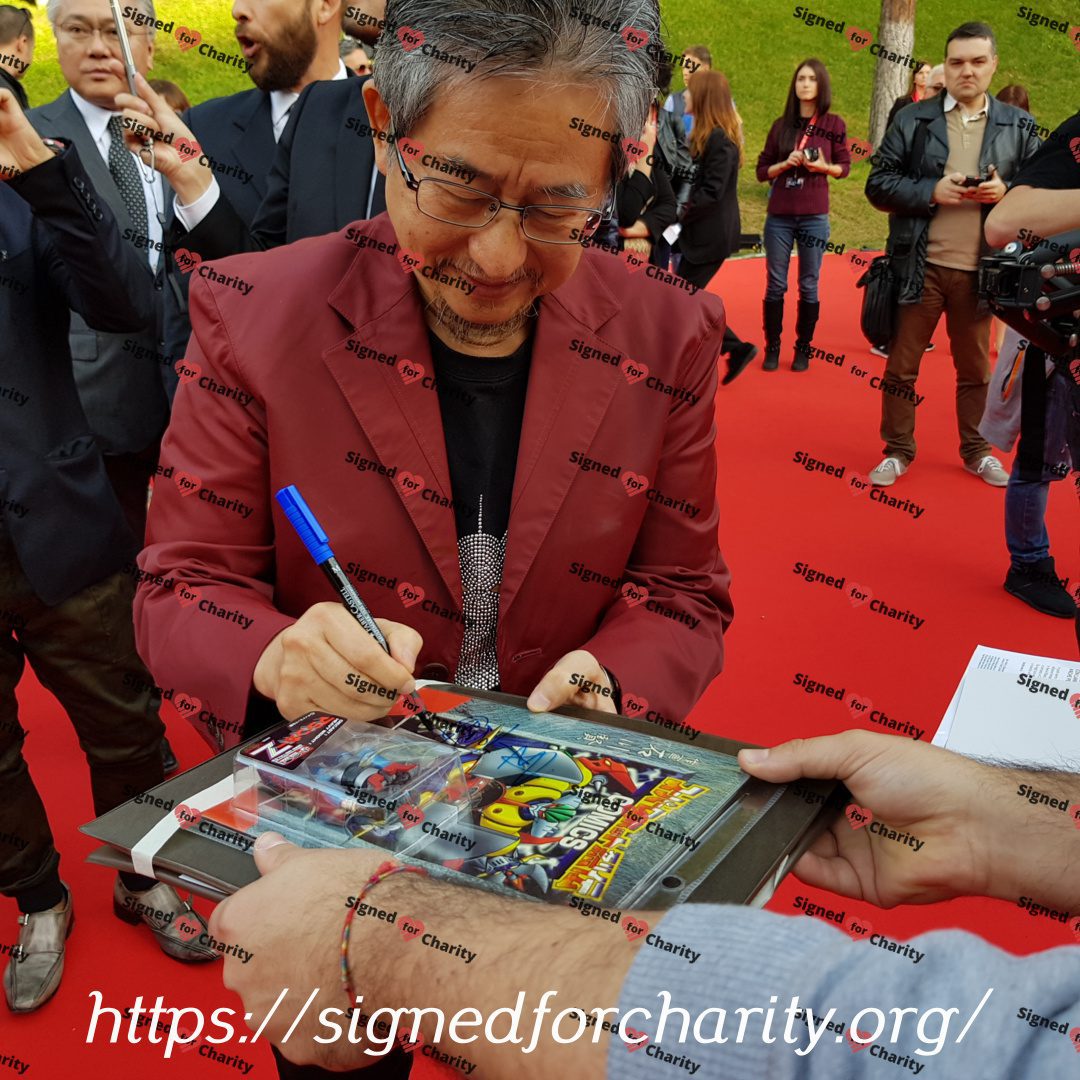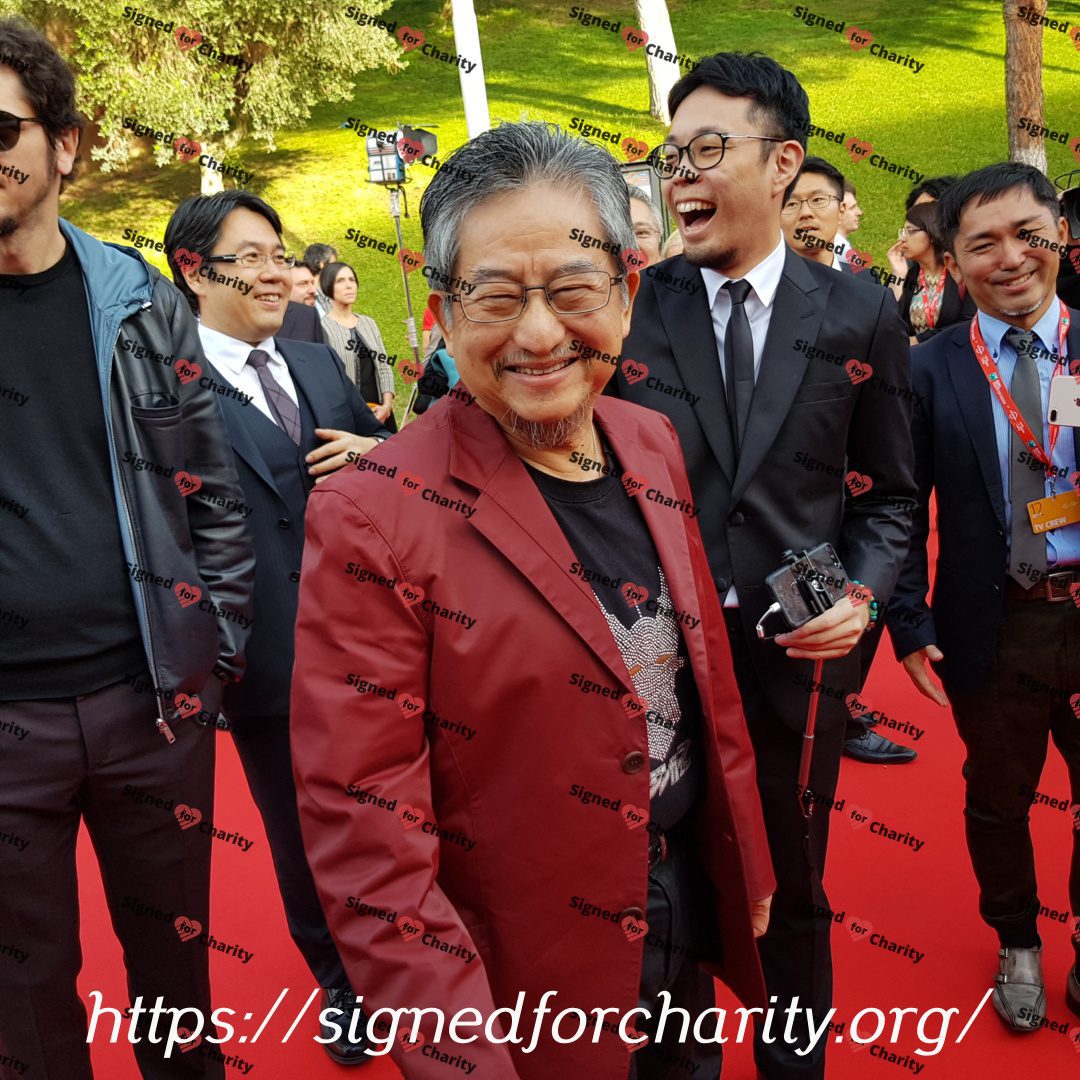Description
KIYOSHI NAGAI BIOGRAPHY :
Kiyoshi Nagai (永井潔, Nagai Kiyoshi, born September 6, 1945), better known by the pen name Go Nagai (永井 豪, Nagai Gō), is a Japanese manga artist and a prolific author of science fiction, fantasy, horror and erotica. He made his professional debut in 1967 with Meakashi Polikichi, but is best known for creating popular 1970s manga and anime series such as Cutie Honey, Devilman and Mazinger Z. He is credited with creating the super robot genre and for designing the first mecha robots piloted by a user from within a cockpit with Mazinger Z, and for pioneering the magical girl genre with Cutie Honey, the post-apocalyptic manga/anime genre with Violence Jack, and the ecchi genre with Harenchi Gakuen. In 2005, he became a Character Design professor at the Osaka University of Arts. He has been a member of the Tezuka Osamu Cultural Prize’s nominating committee since 2009.
Life
Early life
Go Nagai was born on September 6, 1945 – in the Ishikawa Prefecture city of Wajima. He is the son of Yoshio and Fujiko Nagai (永井芳雄・冨士子), and the fourth of five brothers. His family had just returned from Shanghai. While he was still in his early childhood, he along with his mother and his four brothers moved to Tokyo after the death of his father. As a child, he was influenced by the work of Gustave Doré (specifically, a Japanese edition of the Divine Comedy) and Osamu Tezuka (Nagai’s brother Yasutaka gave him a copy of Lost World). He graduated from the Metropolitan Itabashi High School of Tokyo. While passing his ronin year in a prep school in order to earn placement at Waseda University, he suffered a severe case of diarrhea for three weeks. Aware of his own mortality, he wanted to leave some evidence that he had lived, by doing something that he liked as a child: working on manga. He was determined to create one work of manga in what he thought were his last months. As Nagai prepared for the task, he went to the hospital, where he was diagnosed with catarrh of the colon, and soon healed. But this was the turning point in his life. Convinced that he would continue working on manga, he stopped attending school after three months and started living as a ronin. With the help of his brother Yasutaka, he created his first manga works. Despite the fact that his mother opposed his manga aspirations, he submitted his works for publication, accumulating many rejections. It is said that when the young Nagai submitted his tables to publishers, his mother secretly convinced publishers to reject them. However, his work was noticed by Weekly Shōnen Sunday, which contacted Shotaro Ishinomori. Thanks to some trial manga he created with the help of Yasutaka, Nagai was finally accepted into the studio of Ishinomori in 1965. The trial manga was about a science fiction ninja, and was a prototype for a different story, Kuro no Shishi. Nagai was 19 years old when he made this work; it started at 15 or 16 pages and ended up being 88 pages long after a year, and was untitled at that time. Ishinomori saw this work and praised Nagai for it, but commented that the design was too chunky and he should improve it a little. Two or three days later, Nagai was invited to become an assistant to Ishinomori and this work was forgotten until 2007, when it was published in the magazine Comic Ran Twins Sengoku Busho Retsuden (コミック乱 TWINS 戦国武将列伝) by LEED under the name Satsujinsha (殺刃者(さつじんしゃ)). His professional career began in 1967, despite the opposition of his mother.
Early life
Go Nagai was born on September 6, 1945 – in the Ishikawa Prefecture city of Wajima. He is the son of Yoshio and Fujiko Nagai (永井芳雄・冨士子), and the fourth of five brothers. His family had just returned from Shanghai. While he was still in his early childhood, he along with his mother and his four brothers moved to Tokyo after the death of his father. As a child, he was influenced by the work of Gustave Doré (specifically, a Japanese edition of the Divine Comedy) and Osamu Tezuka (Nagai’s brother Yasutaka gave him a copy of Lost World). He graduated from the Metropolitan Itabashi High School of Tokyo. While passing his ronin year in a prep school in order to earn placement at Waseda University, he suffered a severe case of diarrhea for three weeks. Aware of his own mortality, he wanted to leave some evidence that he had lived, by doing something that he liked as a child: working on manga. He was determined to create one work of manga in what he thought were his last months. As Nagai prepared for the task, he went to the hospital, where he was diagnosed with catarrh of the colon, and soon healed. But this was the turning point in his life. Convinced that he would continue working on manga, he stopped attending school after three months and started living as a ronin. With the help of his brother Yasutaka, he created his first manga works. Despite the fact that his mother opposed his manga aspirations, he submitted his works for publication, accumulating many rejections. It is said that when the young Nagai submitted his tables to publishers, his mother secretly convinced publishers to reject them. However, his work was noticed by Weekly Shōnen Sunday, which contacted Shotaro Ishinomori. Thanks to some trial manga he created with the help of Yasutaka, Nagai was finally accepted into the studio of Ishinomori in 1965. The trial manga was about a science fiction ninja, and was a prototype for a different story, Kuro no Shishi. Nagai was 19 years old when he made this work; it started at 15 or 16 pages and ended up being 88 pages long after a year, and was untitled at that time. Ishinomori saw this work and praised Nagai for it, but commented that the design was too chunky and he should improve it a little. Two or three days later, Nagai was invited to become an assistant to Ishinomori and this work was forgotten until 2007, when it was published in the magazine Comic Ran Twins Sengoku Busho Retsuden (コミック乱 TWINS 戦国武将列伝) by LEED under the name Satsujinsha (殺刃者(さつじんしゃ)). His professional career began in 1967, despite the opposition of his mother.
First works
After working as assistant of Shotaro Ishinomori, his very first professional manga work was Meakashi Polikichi (目明しポリ吉 also 目明かしポリ吉), a very short gag comedy one-shot, published in November 1967 in the magazine Bokura by Kodansha. Almost at the same time, this was followed by the manga adaptation of Tomio Sagisu’s TV anime Chibikko Kaiju Yadamon (ちびっこ怪獣ヤダモン, “Little Monster Yadamon”), also published in 1967 in the same magazine. A common misconception is that Kuro no Shishi (“Black Lion”) was his first manga work; while not entirely false, what Nagai really made two years earlier than Meakashi Polikichi, was only a draft for what would later be Kuro no Shishi, which would not be actually published until 1978. His first works consisted entirely of short gag comedy manga. This would change with Harenchi Gakuen.
After working as assistant of Shotaro Ishinomori, his very first professional manga work was Meakashi Polikichi (目明しポリ吉 also 目明かしポリ吉), a very short gag comedy one-shot, published in November 1967 in the magazine Bokura by Kodansha. Almost at the same time, this was followed by the manga adaptation of Tomio Sagisu’s TV anime Chibikko Kaiju Yadamon (ちびっこ怪獣ヤダモン, “Little Monster Yadamon”), also published in 1967 in the same magazine. A common misconception is that Kuro no Shishi (“Black Lion”) was his first manga work; while not entirely false, what Nagai really made two years earlier than Meakashi Polikichi, was only a draft for what would later be Kuro no Shishi, which would not be actually published until 1978. His first works consisted entirely of short gag comedy manga. This would change with Harenchi Gakuen.
First success and controversies
In less than a year after debuting, he met with a big success. After being an unknown manga artist, he became a protagonist of televised debates and journalistic investigations. In 1968, while Shueisha was getting prepared to launch its first manga publication, Shōnen Jump, in order to compete with other magazines from rival companies (like Shōnen Magazine from Kodansha and Shōnen Sunday from Shogakukan), Nagai was invited to be one of the first manga artists publishing in the new magazine. He contemplated this, since he had to design a long-running series instead of the auto-conclusive short stories that he had been developing until that point. He accepted and the series became a big success, being the first for Nagai and making Shōnen Jump sell more than one million copies. With Harenchi Gakuen, Nagai was the first to introduce eroticism in modern manga and became the creator of modern erotic manga, opened the door to a new era in manga and also became the symbol of an entire generation. This work has influenced Japanese society radically, completely changing the common perceptions of manga. Until Harenchi Gakuen, Japanese manga had been relatively tame affairs, but things soon changed. The manga became so popular that several live-action films and TV series based on the manga were developed. Harenchi Gakuen is considered as probably the work that has had the most influence in the world of manga at the end of the 1960s, leading the newly born Shōnen Jump magazine to sell millions of copies per week. A scandalous manga in its time, it is a very innocent series by today’s standards. At the time of its original publication, however, it met with severe criticism by some parts of the Japanese society. Harenchi Gakuen was criticized as vulgar because it introduced overt eroticism to children. Male students and teachers were depicted as being preoccupied with catching glimpses of girls’ panties or naked bodies. Many parents, women’s associations, and PTAs protested. In particular, the PTA protests over Harenchi Gakuen were notorious. Nagai was bombarded with interview requests from newspapers, magazines and TV. Whenever he flew outside of Tokyo, TV cameras were waiting for him. He was branded a “nuisance” and even an “enemy of society”. He, however, had a clear sense of what things he could or could not do with the manga. At first, Nagai did not think that the opposition was against him, since he was aware of the standards that applied with movies and similar things for an audience below 18 years old. At that time, he never drew sex scenes, avoided pictures of genitals and made nudes cute rather than sexy, though the manga regularly showed male genitals throughout its run, including a castration scene. His fans supported him throughout the PTA protests. They sent him letters where they expressed how they were aware that the adults cracking down on them were reading raunchier stuff than what Nagai was producing. The protests were not only against the manga, but also against the TV series. The PTA managed to prevent the distribution of the magazine in some parts of Japan. As a result of the protests, when the series was about to be cancelled because of the PTA, Nagai changed the theme in Harenchi Gakuen into a more mature and serious matter, from nonsense gags with sexy touches, to a full-scale war where murder was depicted in the bloody way for which many know him. This led to the famous ending of Harenchi Gakuen, symbol of freedom and of rejection of the hypocrisy, where all students and teachers, while defending their freedom of expression, are killed by the PTA and other parental forces. This was the ironic answer that Nagai gave to the PTA. It was also around that time that he created Gakuen Taikutsu Otoko (ガクエン退屈男), also known as Guerrilla High, another school-themed manga, but this time war between youths and adults was the main theme. Shortly before that, in 1969, Abashiri Ikka (あばしり一家) was created. Both titles are a direct result of the PTA protests, both being a form of parody of what happened. Abashiri Ikka became a big success, and along with Harenchi Gakuen, the most popular series of Nagai’s juvenile period.
Dynamic Productions
Thanks to the success of Harenchi Gakuen, Dynamic Productions (ダイナミックプロダクション, also known as Dynamic Production or Dynamic Pro, ダイナミックプロ), was founded by Go Nagai with his brothers in April 1969. Meant to be a group to help him with his works, as a consequence Harenchi Gakuen, where he derived almost no royalties from the TV series, films, or related merchandise, Dynamic Productions became a company established to manage Nagai’s relations and contractual rights of his work. Dynamic became one of the first companies to require publishers sign contracts (even today many manga are created and published only on the basis of verbal agreements). It would start as a yugen kaisha (limited company) and would change to a kabushiki kaisha (stock company) in 1970. The same year of the foundation of Dynamic Pro, Ken Ishikawa joined the company. He would become Nagai’s second assistant after Mitsuru Hiruta, who had been working with Nagai since the beginnings of Harenchi Gakuen. He would become one of Nagai’s regular partners and his best friend. Ken Ishikawa participated as assistant in Harenchi Gakuen, Abashiri Ikka and Gakuen Taikutsu Otoko, particularly in the last one. In parallel with those activities as assistant, he co-produces with Go Nagai what would be in fact his professional debut in manga, Gakuen Bangaichi (1969-09-08 ~ 1970-09-22), and also his second manga, Sasurai Gakuto (1970-01 ~ 1970-05). He temporarily quit Dynamic Productions in 1970. This prompted Nagai to end Gakuen Taikutsu Otoko and the story of this series would be left inconclusive.
Thanks to the success of Harenchi Gakuen, Dynamic Productions (ダイナミックプロダクション, also known as Dynamic Production or Dynamic Pro, ダイナミックプロ), was founded by Go Nagai with his brothers in April 1969. Meant to be a group to help him with his works, as a consequence Harenchi Gakuen, where he derived almost no royalties from the TV series, films, or related merchandise, Dynamic Productions became a company established to manage Nagai’s relations and contractual rights of his work. Dynamic became one of the first companies to require publishers sign contracts (even today many manga are created and published only on the basis of verbal agreements). It would start as a yugen kaisha (limited company) and would change to a kabushiki kaisha (stock company) in 1970. The same year of the foundation of Dynamic Pro, Ken Ishikawa joined the company. He would become Nagai’s second assistant after Mitsuru Hiruta, who had been working with Nagai since the beginnings of Harenchi Gakuen. He would become one of Nagai’s regular partners and his best friend. Ken Ishikawa participated as assistant in Harenchi Gakuen, Abashiri Ikka and Gakuen Taikutsu Otoko, particularly in the last one. In parallel with those activities as assistant, he co-produces with Go Nagai what would be in fact his professional debut in manga, Gakuen Bangaichi (1969-09-08 ~ 1970-09-22), and also his second manga, Sasurai Gakuto (1970-01 ~ 1970-05). He temporarily quit Dynamic Productions in 1970. This prompted Nagai to end Gakuen Taikutsu Otoko and the story of this series would be left inconclusive.











